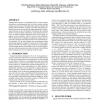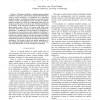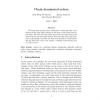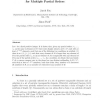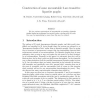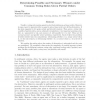121
click to vote
PVLDB
2010
14 years 8 months ago
2010
Although there has been a considerable body of work on skyline evaluation in multidimensional data with totally ordered attribute domains, there are only a few methods that consid...
123
click to vote
LICS
2010
IEEE
14 years 11 months ago
2010
IEEE
—This paper establishes a bridge between presheaf models for concurrency and the more operationally-informative world of event structures. It concentrates on a particular preshea...
114
click to vote
ORDER
2006
15 years 1 months ago
2006
We study finite partial orders which have a chain such that every element of the order either belongs to this chain or has all its covers in this chain. We show that such orders a...
116
click to vote
ORDER
2006
15 years 1 months ago
2006
Let r be a fixed positive integer. It is shown that, given any partial orders >1, . . ., >r on the same n-element set P, there exist disjoint subsets A, B P, each with at l...
151
click to vote
FUIN
2007
15 years 1 months ago
2007
Mazurkiewicz traces form a model for concurrency. Temporal logic st-order logic are important tools in order to deal with the abstract behavior of such systems. Since typical prop...
104
click to vote
ORDER
2008
15 years 1 months ago
2008
We give various constructions of uncountable arc-transitive bipartite graphs employing techniques from partial orders, starting with the cyclefree case, but generalizing to cases ...
102
click to vote
DAM
2007
15 years 1 months ago
2007
In the partially-ordered knapsack problem (POK) we are given a set N of items and a partial order ≺P on N. Each item has a size and an associated weight. The objective is to pac...
128
click to vote
CMS
2006
15 years 2 months ago
2006
This paper presents a model for delegation based on partial orders, proposing the subclass relation in OWL as a way to represent the partial orders. Delegation and authorization de...
131
click to vote
AAAI
2008
15 years 3 months ago
2008
Usually a voting rule requires agents to give their preferences as linear orders. However, in some cases it is impractical for an agent to give a linear order over all the alterna...
112
click to vote
CADE
1994
Springer
15 years 5 months ago
1994
Springer
In this paper we investigate the concept of simple termination. A term rewriting system is called simply terminating if its termination can be proved by means of a simpli cation o...
